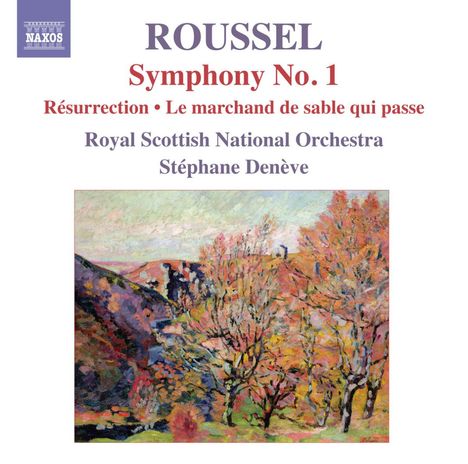Albert Roussel: Symphonie Nr.1 "Le Poeme de la Foret" auf CD
Symphonie Nr.1 "Le Poeme de la Foret"
Herkömmliche CD, die mit allen CD-Playern und Computerlaufwerken, aber auch mit den meisten SACD- oder Multiplayern abspielbar ist.
Lassen Sie sich über unseren eCourier benachrichtigen, falls das Produkt bestellt werden kann.
+Resurrection; Le marchand de sable qui passe (Bühnenmusik)
- Künstler:
- Royal Scottish National Orchestra, Stephane Deneve
- Label:
- Naxos
- Aufnahmejahr ca.:
- 2008/2009
- UPC/EAN:
- 0747313032372
- Erscheinungstermin:
- 9.11.2009
Ähnliche Artikel
Die Erste Symphonie nahm in den Jahren 1904-06 Gestalt an und wurde erstmals am 22. März 1908 in Brüssel unter der Leitung von Sylvain Dupuis vollständig gehört. Trotz des Untertitels, Gedicht des Waldes, ist dies kein programmatisches Werk; vielmehr stellen die vier Sätze einen jahreszeitlichen Verlauf nach der Reihenfolge Winter-Frühling-Sommer-Herbst dar. Eine Verschmelzung zwischen der oft beschreibenden Art Debussys und "zyklischen" formalen Prozeduren, für die Roussels Lehrer d'Indy eintrat, ist im ganzen Stück offensichtlich.
Der Wald im Winter taucht aus einem sanften Dunstschleier auf Holzbläsern und Streichern, Fagott, Flöte und Klarinette auf, die versuchsweise eine melodische Phrase gegen eine wellenförmige Figuration auf Streichern setzen. Es wird der Oboe überlassen, die eigentliche Melodie zu entfalten, wonach eine Steigerung der Aktivität zu einem Höhepunkt führt, bei dem das Thema von Streichern aufgegriffen wird. Die Spannung klingt schnell ab, und das Horn erklingt musikantisch, wenn sich der Satz seinem Ende nähert. Ohne Pause beginnt die Erneuerung mit einer lebhaften Aktivität auf Holzbläsern und Streichern, wobei die tieferen Streicher ein rhapsodisches Thema entfalten, das durch eine skurrile Idee auf Flöte und Harfe ergänzt wird. Das Hauptthema wird von den Streichern als Ganzes übernommen, wobei die Orchestrierung mit zunehmender Aktivität immer abwechslungsreicher wird. Blechbläser und Schlagzeug erzeugen einen energischen Höhepunkt, bevor die Flöten- und Harfenidee den Satz mit einem Crescendo, gefolgt von einem letzten Aktivitätsschub, zu Ende führt.
Product Information
The First Symphony took shape during 1904–06 and was first heard complete in Brussels on 22 March 1908, Sylvain Dupuis conducting. Despite the subtitle, Poem of the Forest, this is no programmatic work; rather its four movements portray a seasonal course following the order Winter-Spring-Summer-Autumn. An amalgam between the often descriptive manner of Debussy and ‘cyclical’ formal procedures espoused by Roussel’s teacher d’Indy is evident throughout the piece.
The Forest in Winter emerges out of a gentle haze on woodwind and strings, bassoon, flute and clarinet tentatively stating a melodic phrase against undulating figuration on strings. It is left to the oboe to unfold the actual melody, after which an increase in activity leads to a climax with the theme taken up by strings. Tension quickly subsides, and the horn sounds out musingly as the movement draws to its close. Without pause, Renewal starts with animated activity on woodwind and strings, the lower strings unfolding a rhapsodic theme complemented by a whimsical idea on flute and harp. The main theme is taken by strings as a whole, the orchestration becoming more varied as the activity increases. Brass and percussion bring about an energetic climax, before the flute and harp idea sees the movement to its conclusion with a crescendo followed by a last surge of activity.
Disk 1 von 1 (CD)
-
1 Symphony No. 1, Op. 7, "Le poeme de la foret": I. Foret d'hiver
-
2 Symphony No. 1, Op. 7, "Le poeme de la foret": II. Renouveau
-
3 Symphony No. 1, Op. 7, "le Poeme De La Foret": Iii. Soir D'ete
-
4 Symphony No. 1, Op. 7, "Le poeme de la foret": IV. Faunes et dryades
-
5 Resurrection, Op. 4
-
6 Le marchand de sable qui passe, Op. 13: Prelude
-
7 Le marchand de sable qui passe, Op. 13: Scene 2
-
8 Le marchand de sable qui passe, Op. 13: Interlude - Scene 4
-
9 Le marchand de sable qui passe, Op. 13: Final Scene










